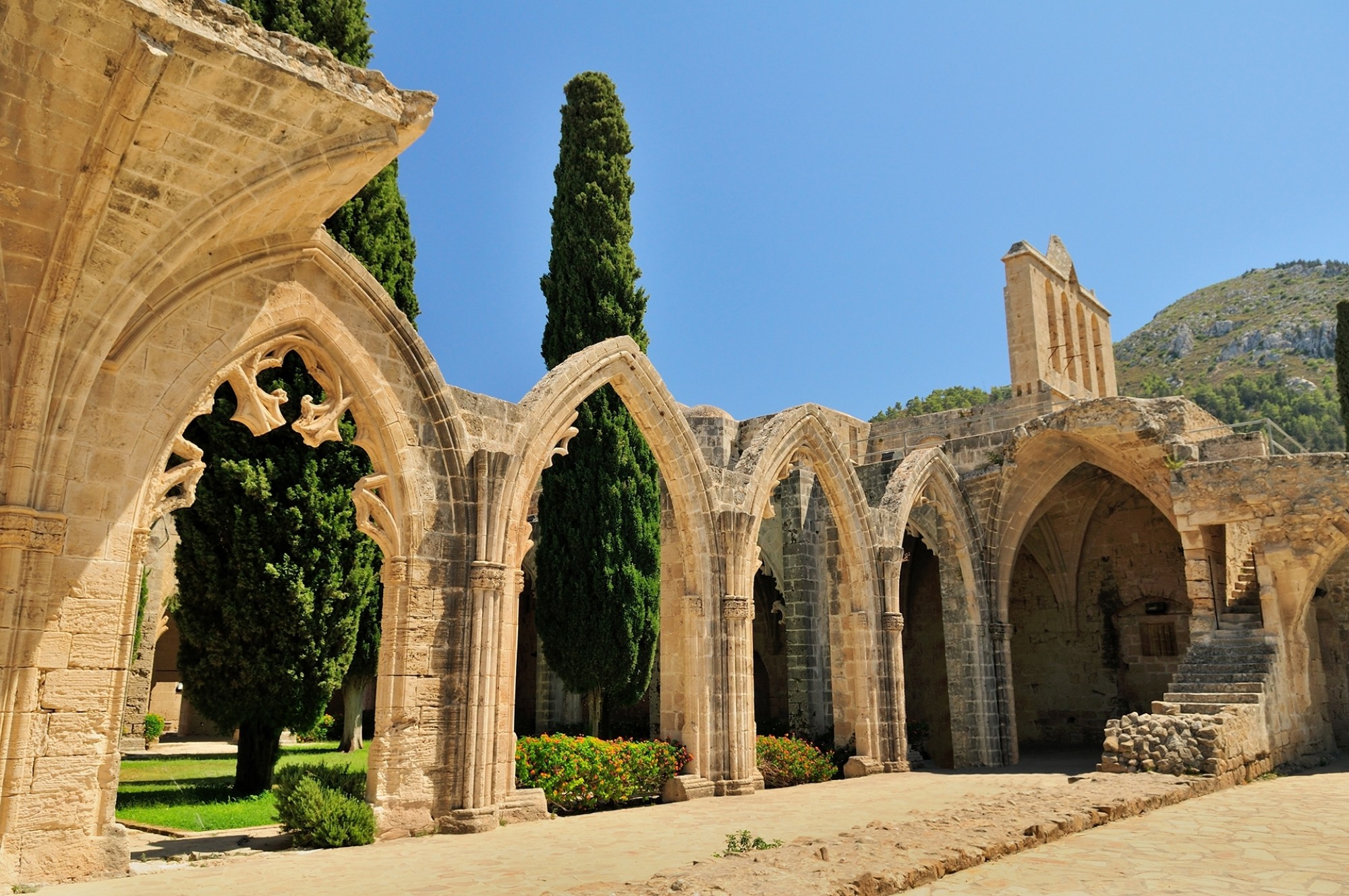









With evocative ruined castles clinging to craggy mountainsides, glorious sunshine piercing the sapphire waters, and forgotten towns just begging to be explored, northern Cyprus offers a return to the Mediterranean as it once was. Despite its tumultuous recent history, northern Cyprus is bursting with authentic local cuisine, warm and friendly people, and bustling markets. These all rub shoulders with the traces of a more ancient, epic past: fortifications, monasteries and archaeological sites reveal the many layers of culture and myth which have merged to create the charm of Cyprus and tell the story of the Mediterranean.
based on two sharing in a twin/double room, with a minimum of 30 passengers travelling in a specific month
March, April, May, June, September, October, November
Not the hotel for your group? Other hotels are available, contact us.

The magnificent ruins of St Hilarion Castle cut an evocative silhouette. This romantic stronghold juts from the rock and overlooks the Kyrenia plain, and due to its lofty, defensive position it has a chequered history of occupation. Culminating in a Byzantine tower, St Hilarion Castle is a dreamy amalgamation of twisting stairways, secret rooms, hidden tunnels and spectacular vistas.

Kyrenia, also known as Girne, is a beautiful harbour town pleasantly cooled by mountain breezes. Kyrenia’s compact ancient quarter circles the natural harbour, and its narrow lanes hark back to days gone by. Kyrenia’s honey-hued castle is a squat bastion of Byzantine, Lusignan and Venetian construction with a fascinating history.

The pretty village of Bellapais, situated within the Kyrenia Mountains, was immortalised by writer Lawrence Durrell in the 1950s and has retained its old-world Mediterranean charm. The highlight of the village is Bellapais Abbey, a striking medieval monastery which looks out towards the blue of the ocean.

Ancient Salamis is a striking archaeological site which tells the story of life in Cyprus over 3,000 years ago. Dotted with monuments, marble columns and important relics predominately dating back to the Roman and Byzantine occupations, Salamis was once the most important city on the island. Steeped in both history and myth, and with features such as bathhouses, statues, temples and an amphitheatre, this site makes for a fascinating visit.
This revered religious site is formed of an 18th century structure built upon (and incorporating) the crumbled ruins of a Byzantine church. Famed as the resting place of St Barnabas, the patron saint of Cyprus, the tomb where the miraculous discovery was made is marked by a mausoleum, and a museum houses several artefacts and antiquities from northern Cyprus.

A ghost town and sad victim of the complex politics of Cyprus’ two halves, Famagusta was once a bustling and glamorous resort town which is now frozen in time. Following the coup of 1974, the Turkish Army invaded and occupied Famagusta and the new town remains inaccessible to this day. The devastated neighbourhoods within old town of Famagusta can be visited, where you can see the fascinating mix of Gothic architecture, dramatic Venetian fortifications and Ottoman culture that formed this once-important settlement.
This wild and windy castle is the highest of the three fortresses in the Kyrenia mountain range. The atmospheric and dilapidated ruins are today grazed by goats and circled by buzzards, but have witnessed hundreds of years of invasion and occupation, surrendering to Richard the Lionheart in the 12th century before falling into disrepair under the Venetians.
Meaning ‘beautiful place’, Güzelyurt is a fertile town situated by the foothills of the Troodos Mountains and known for its incredible abundance of Mediterranean vegetables, plump fruits and sticky dates. Surrounded by citrus plantations, the countryside surrounding the town is beautiful and unspoilt, and Güzelyurt has a lively Saturday market and several good restaurants where you can sample the delights of the local produce.
Kyrenia’s fascinating Icon Museum is an important collection of preserved icons, salvaged from looted churches following the partition of the island in the 1970s. Housed inside a former Greek Orthodox church, it displays examples from the 17th to 19th centuries, although the origin of all the works is not known. These captivating artworks demonstrate a skill and craftsmanship particular to Cyprus, revealing much about both the art and history of the island.
Surrounded by wild flowers and birdsong, this enigmatic ancient settlement has an uncertain history but is believed to have been built by the Persians around 500BC, before being destroyed by fire some 150 years later. With some architectural features in the Persian style, the palace complex consists of three terraces and traces of early hot baths are evident. Sitting high upon a hill, the views from Vouni are magnificent.
Nicosia is the world’s last divided capital, with a stunning old town and impressive Venetian city walls. Discover the main square, the Bandabuliya covered bazaar, and the staggering Venetian column, Selimnye Mosque, visible from both sides of the capital and its most historically significant mosque.

4 minute read
10 photos
The month of May saw me head out to the northern part of Cyprus in search of fresh itinerary ideas for our clients. I love to be able to offer more off-the-beaten-track destinations to our groups so that they can enjoy wonderful areas of the world without the crowds, and...

By Tony Flanagan
20th Sept 2019
Hand picked destinations
Romania
Transylvania is a rural, Romanian tapestry of verdant vales and cultural treasures. A variety of fascinating castles spiral out from the landscape, baroque buildings line grand squares, and Saxon villages harbour fortified churches.
Itinerary Highlights
Details
Italy
With its mild climate, extravagant villas and stunning scenery, the Italian Riviera is truly charming. Known as the ‘Riviera of Flowers’, it retains all the elegance of its neighbour, the French Riviera, but with plenty of Italian character.
Itinerary Highlights
Details